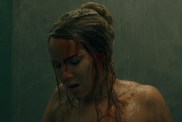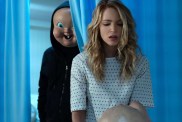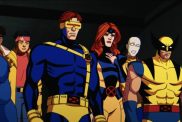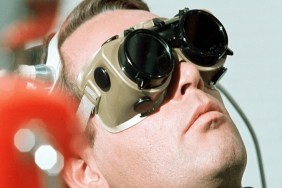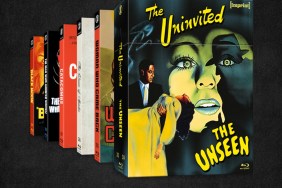
We’ve reached the end of the road as I bring you the third and final installment in my interview with director William Friedkin whose latest film, Killer Joe, hits limited theaters today and will expand throughout August (click here for a list of theaters).
After making films for 45 years, Friedkin has seen a lot of changes with the latest focus being on digital filmmaking, 3-D and even he brings up the push for filming and projecting at a higher frame rate. He has adopted one of these modern era techniques, but disregards the two others while showing a clear fascination with high definition video and Blu-rays.
Friedkin took a lot of heat, in fact, for the remastered presentation of his 1971 classic The French Connection when it hit Blu-ray back in 2009. On the disc he proclaimed it to be the best he believes the film has ever looked. To say his claim was met with a raised eyebrow would be an understatement. Even French Connection cinematographer Owen Roizman came out against the transfer saying:
“Billy [Friedkin] for some reason decided to do this on his own. I wasn’t consulted. I was appalled by it. I don’t know what Billy was thinking. It’s not the film that I shot, and I certainly want to wash my hands of having had anything to do with this transfer, which I feel is atrocious.”
Three years after that Blu-ray release, in March of 2012, Fox Home Entertainment released a new edition of the French Connection Blu-ray in which the detractors of the first edition began to praise the latest. Here’s the rub, Friedkin agrees the first copy was terrible. So how did it make it to the shelves? You’re about to find that out and a little more…

What is your opinion of the state of filmmaking today? Things such as 3-D, the argument over digital vs. film, video on demand, where do you stand?
William Friedkin (WF): I don’t like 3-D. I don’t believe it’s necessary. It’s simply a gimmick. The art of film, the art of cinema, is the illusion of depth in a two-dimensional world, which is just height and width. That’s true of painting and it’s true of films.
You don’t need to see a great painting in 3-D do you? If you’ve ever seen one of the masters, you don’t to see their paintings in 3-D. The greatest films I’ve ever seen are in black-and-white as a matter of fact, they’re certainly not in 3-D.
Is it temporary? I don’t know. When it was originally introduced in the 1950s it was a temporary phenomenon and now I think it will survive only based on the kinds of films that resonate with the public.
Now they want to change the frame rate of films and have the theater owners convert their projectors so that instead of 24 frames per second, [they’ll play at] 48 and even 60 [frames per second] and that’s very costly. So I don’t know if that’s going to take off either.
But I think the movies that are made today are much better made than what we made in the ’70s and even before — technically. Technically now a director can achieve anything you can conceive of. It’s achievable in the digital world or with computer graphic imagery, but I don’t think, necessarily, the stories are better, or the acting is any better. I just think it’s more about comic books and video games than anything else. There are exceptions, but they’re not the big hits that the digital shows are.
And what are your thoughts on digital vs. film. Did you shoot Killer Joe on film?
WF: We shot on digital, I think it’s better. 35mm is basically gone. Eastman Kodak isn’t making the stock anymore. As of 2013 there won’t be any 35mm film stock and all the theaters will have been converted to play digital. So no one is really playing 35mm except art film houses and they’re playing old prints. It has been phased out and will be phased out totally after next year.
It’s just an evolution of the technical process, like 33 1/3 LPs were replaced by CDs and I don’t know how many people out there are saying, “Oh, I wish I could have heard this record on 33 1/3 so I could pick up the needle scratch and some of the noise.” You’re very happy, I think, to hear the pure sound.

This discussion of quality makes me think of the situation with the Blu-ray for The French Connection, your restoration of the film and when your cinematographer, Owen Roizman, made a comment on the transfer calling it “atrocious.”
WF: He had never seen the master. He saw a store bought copy and he was shocked and I hadn’t seen a store bought copy. And then Owen told me what his looked like and I saw it and it was terrible.
So we then went out and we bought two copies of the Blu-ray that 20th Century Fox had made, one from Best Buy and another from Amazon. We got two different copies from two different places and they were awful. In fact, they had a warning in the box. They had a warning label inside the cover saying, “This video may not play well on your home player.”
The first Blu-ray that went out?
WF: Yes. And it said, “If it doesn’t look good go to www dot something and we’ll send you a correction disc that you can then run through your player and then you’ll see what it should look like.” I didn’t know about that.
I made the master and the master was beautiful and I brought Owen in to see the master and he looked at it and said, “This is great! It’s perfect.”
The release prints, which go to four different companies, four different stages, were horrible. So the two of us, we made a new Blu-ray about six months ago.
So the follow-up was a collaboration between the two of you?
WF: Yes it is, but it’s not because it’s any different. I just invited Owen to come in. Owen’s been long retired. I brought him in to look at it because he is the guy that discovered the release copies the public bought were horrible. I readily admit that, but he readily admits, if you call him, that the masters were great. It just didn’t reproduce for some reason and either they didn’t figure it out, or they never told me what happened, but we put on so much pressure that we remade new Blu-rays that now appear to be okay.

We don’t control the release copies. We make a master in which the only thing I do is try to restore the original color because the prints, the 35mm prints that people see over the last 40 years, are faded, dated, dirty, scratchy, spliced and so the only you do as a supervisor of a digital master is you can try and get the color back to where it should be by working with the original negative and you change the densities so they are more compatible with the home video system than a movie screen and the tones. That’s all. You don’t do any massive changes.
In fact, every negative has to be color timed to produce 35mm prints and there’s a lot of trial and error in that because the composition of the water is different to the developer and the electricity fluctuates to the printer. There are a lot of imperfect 35mm prints out there that people have fond memories of, but it’s their own memory playing tricks.
SIDE NOTE: The saddest thing is the original Blu-ray release of The French Connection is still being sold. The only place you can buy the corrected version is at Best Buy as [amazon asin=”B001JNNDAQ” text=”Amazon”] is still selling the 2009 original.
And that does it. I hope you enjoy all three parts of this interview and if you haven’t yet read parts one and two just use the navigation below to give those a read.
PART TWO | PART THREE
